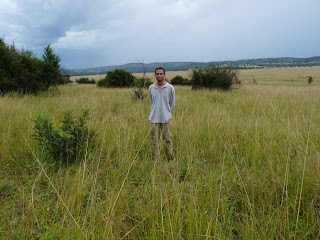town of Ruhengheri to see the mountain gorillas and hike a
volcano. This is where Dian Fossey of `Gorillas in the Mist'
fame did her work. (I didn't know this but she was at Cornell
from `81 to `83 before she was killed in `85.) At this time of
year the weather is supposed to be lousy, rainy and overcast.
We had two great days. You get to the park and then because
our group was far away we drove about an hour and a half on
very bad roads to the hike. At first we went through this

amazing bamboo forest. The stalks were 30 feet and taller.
I've never seen anything like it. We started at around 8000
feet and hiked up to over 9000. The guide was in contact with
trackers. It took longer than usual to find the group (about 40
gorillas), a total of 3.5 hours of hiking on trails and
bushwhacking when necessary. The guides had machetes and cut down
bamboo when we went off trail.
This is Magilla.

If you don't get the reference you are too old, too young, or
my age and you frittered away your youth by not watching
enough cartoons on TV. So you get to the group and they go over
the etiquette. No pointing as the gorillas think you are throwing
something at them. Eye contact is fine. Don't go closer than 7
meters, though if the gorillas approach slowly, then back up slowly.
If they charge (they do this as a feint, for fun), crouch down.
You get one hour with them. In the first 5 minutes we got a
couple of vigorous chest beatings and one charge. We all backed
away rather than crouch! This shows you how close we got them.

The big males, silverbacks because the hair on their backs turns
silver, can go over 450 pounds. The boss of the group, who saw
us arrive and then went off was massive. His head was the size
of my torso (ok, in my case that isn't saying much). Here are a
few more pictures.



For the record, Dian Fossey disapproved of this sort of tourism.
In her day poaching was the issue and she organized antipoaching
patrols. Now that isn't a problem and they have the one hour limit.
The gorillas don't seem to mind us at all, but there is the health
risk that humans bring to gorillas and the question of whether
having their day upset for an hour is a bad for them. On the flip
side this brings HUGE amounts of money into an impoverished country.
It costs $500 to go on this trip and that does not count hotel,
transport etc. You only hope the money is not lining bureaucrats'
pockets.
I need to go do math - volcanoes will come later.




















